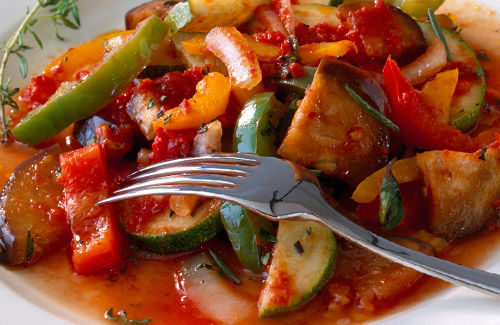Ratatouille: Not Just a Movie about a Mouse
Posted on November 5th, 2013 by Jonah Arellano in Uncategorized | No Comments »
I should probably preface this by saying that I have a daughter. She’s two and a half, in case that makes a difference. So it goes without saying that I watch more than my fair share of animated movies. Seeing as my daughter is currently on a veggie strike (she smells her food, and regardless of how tasty something smells if it has the least bit of green or red it gets an “ewww” from her) I thought I might as well put those cartoon characters to good use and encourage more diverse eating habits. So I popped Disney’s Ratatouille into the DVD player and hoped for the best.
“Why is it called Ratatouille?” asked my husband when he walked in half way through the movie.
“Because it’s a movie about a rat who can cook, and the first part of ‘Ratatouille’ is ‘rat’.”
“So Ratatouille is a real food?”
“YES! It’s French, now be quite so we can watch the movie.” My daughter chose this moment to give my husband and me a stern look before turning her attention back to the movie.
 Ratatouille is a traditional French Provençal stewed vegetable dish. The full name of the dish is ratatouille niçoise, and like the name indicates, it originated from Nice. It can be served as a meal, if accompanied by rice or pasta, but ratatouille is generally served as a side dish.
Ratatouille is a traditional French Provençal stewed vegetable dish. The full name of the dish is ratatouille niçoise, and like the name indicates, it originated from Nice. It can be served as a meal, if accompanied by rice or pasta, but ratatouille is generally served as a side dish.
There’s a good amount of debate on how to make a traditional ratatouille; some cooks chop and sauté, others slice, layer, and bake. Most cooks can agree, however, on the key ingredients: tomatoes, garlic, onions, courgette, aubergine, and bell peppers.
The version of ratatouille from the film is called Confit Byaldi, a more contemporary take on a nouvelle cuisine dish by Michel Guérard, which was popularized by American chef Thomas Keller in his cookbook, The French Laundry Cookbook.
 While the movie progressed and the rat and reluctant cook became friends and co-conspirators, the accordion-heavy soundtrack wasn’t the only thing floating in the air, so was the smell of some yummy ratatouille I had popped into the oven ahead of time. By the time the food critic had a plate of the movie’s namesake in front of him, so did my daughter. She doesn’t yet possess the language skills to have given a detailed account of her thoughts on it, but she cleaned her plate and that’s as good as a “délicieux” to me.
While the movie progressed and the rat and reluctant cook became friends and co-conspirators, the accordion-heavy soundtrack wasn’t the only thing floating in the air, so was the smell of some yummy ratatouille I had popped into the oven ahead of time. By the time the food critic had a plate of the movie’s namesake in front of him, so did my daughter. She doesn’t yet possess the language skills to have given a detailed account of her thoughts on it, but she cleaned her plate and that’s as good as a “délicieux” to me.
The recipe I made wasn’t the most traditional, but if that’s something you’re looking for then the internet has a wealth of recipes (including the movie version).
Do you have any favorite traditional French recipes?
Are there any you’d like to know more about?






